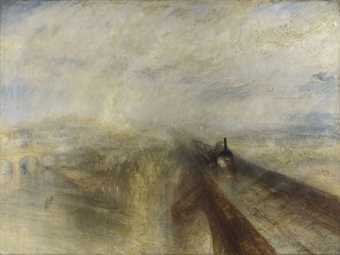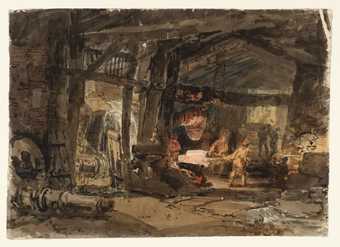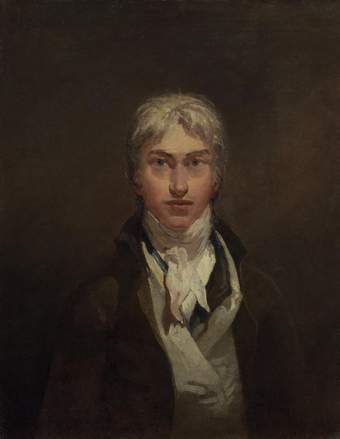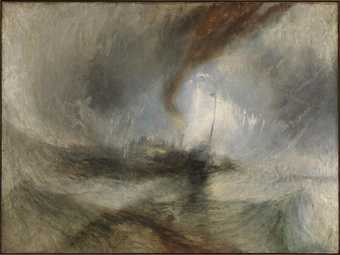
Joseph Mallord William Turner
Snow Storm - Steam-Boat off a Harbour’s Mouth (exhibited 1842)
Tate
We celebrate Joseph Mallord William Turner (1775– 1851) as a great landscape painter, a genius of flaring sunsets and stormy seas, but his excitement at modernity – the new technology, the discoveries of science, the wonders of industry – also poured into his art in a way not often recognised.
Turner’s life spanned the move from sail to steam, from high Georgian times to Victorian heyday. As a boy, he lived among the workshops and warehouses of Covent Garden; in 1851, aged 76, he visited The Great Exhibition of the Works of Industry of All Nations in the Crystal Palace – and, unlike many contemporaries, he revelled in the dawn of the machine age.
In his long working life, Turner explored the changing political, social and industrial worlds. In his art, he adapted grand ‘history painting’ to recent events and current subjects: from the horror of enslaved people thrown overboard from a British slave ship in 1781 (depicted in Slave Ship 1840) to Napoleon’s 1800 crossing of the Alps, Nelson’s death in 1805 at Trafalgar, the mingled dead of Waterloo in 1815, and the 1834 burning of Parliament. He painted all degrees of life, from aristocrats enjoying their great estates to men ploughing or struggling with fishing boats in a squall.
He returned often to industrial scenes, from the forge of a country blacksmith to the smoking factories of Birmingham and Dudley. In Shields, on the River Tyne 1823 he paints men loading coal on the wharves, transforming the classical, sunlit port scenes of Claude Lorrain (1600–1682), an artist he greatly admired, into a modern drama of labour, unceasing even under the moon.
In his keen response to the fire and force of industry, he followed the lead of artists like Philip James de Loutherbourg (1740–1812), who painted the ironworks of Coalbrookdale as a glowing volcano in 1801. But the thrust of progress hums even in the background of Turner’s picturesque landscapes, such as in Kirkstall Lock, on the River Aire 1824–5, where an ancient abbey shares the paper with men quarrying stone for new buildings, and the canal barges seem asleep while the coach dashes by in the background.

Joseph Mallord William Turner
Kirkstall Lock, on the River Aire (1824–5)
Tate
Turner was also fascinated by new explanations of how we see the world, intrigued by experiments on optics, light, heat and atmosphere. In his time, a knowledge of ‘natural philosophy’ was as much a part of polite culture as art and music, literature and history. The Royal Academy – where he began training at the early age of 14 – shared its premises at Somerset House with the Royal Society; scientists and artists mingled, talked and argued here, and in clubs and social gatherings.
The excitement was palpable. Lectures on chemistry by Humphry Davy and, later, Michael Faraday, drew huge crowds; geologists argued over the creation of the earth and the fossil record; astronomers William and Caroline Herschel gazed at the stars through powerful new telescopes. William Herschel’s 1801 lecture describing ridges, flecks and chasms on the surface of the sun has been seen as inspiring Turner’s sun in paintings such as The Festival upon the Opening of the Vintage of Mâcon c.1803, where it appears as an orb thick with paint, scarred and lined, obscured by mist – almost blinding in its power.
Absorbing the latest knowledge, Turner saw the physical world through fresh eyes. The geologist Charles Lyell admired his drawings of glaciers and rock faces for their accuracy, while the daughter of John McCullough, an early member of the Geological Society, recalled Turner’s interest in the subject and her father’s delight at the artist’s acute mind: he claimed that Turner ‘would have been great in any – and everything – he chose to take up. He has such a clear, intelligent, piercing intellect’.
Intellect was matched by devouring curiosity. In Rome, in 1819, Turner met Davy, with whom he shared an interest in Raphael, as well as in colour theory, geology – and fishing. Later, with Faraday, he discussed the fading of pigments, the chemistry of colour and the nature of light.
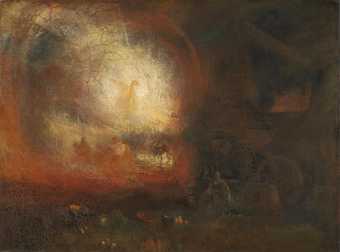
Joseph Mallord William Turner
The Hero of a Hundred Fights (c.1800–10, reworked and exhibited 1847)
Tate
As a young architectural draughtsman working on plans and elevations, he had gained an understanding of Euclidean geometry, which showed in his fine diagrams for his Royal Academy lectures on perspective, even while people laughed at his cockney accent. But his interest in mathematics and complex geometry went beyond this to a sense of the interconnectedness of all aspects of life. In Turner and the Scientists (1998), his biographer James Hamilton quotes a lecture from 1818: ‘the cell of the Bee and the Basaltic mass display the like Geometric form, of whose elementary principles all Nature partakes’.
One of Turner’s close friends was the mathematician Mary Somerville (also a good friend of Davy), who inspired a generation of readers through her translation of Pierre-Simon Laplace’s Mechanism of the Heavens (1831), which Turner owned, and her writing on a wealth of subjects in On the Connexion of the Physical Sciences (1834).
In line with his interest in magnetism, Turner followed Somerville’s experiment on the magnetising power of violet light in the spectrum in the 1820s. ‘I frequently went to Turner’s studio,’ Somerville wrote in her Personal Recollections (1873), ‘and was always welcomed. No one could imagine that so much poetic feeling existed in so rough an exterior.’ She was right: Turner could translate this new knowledge into visual poetry. His work, with its sense of infinite depths, reflects the ‘magnitude and splendour’ that Somerville found in the stars, which ‘impress the mind with some notion of the energy that maintains them in their motions with a durability to which we can see no limits’.
As a painter of the heavens, Turner knew of chemist and meteorologist Luke Howard’s groundbreaking cloud classification of 1803, and hydrographer Francis Beaufort’s revolutionary wind force scale of 1805. He had his own telescopes and globes, and his Skies sketchbook of 1816–18 contains studies made over many days.
Turner was interested, above all, in light. In relation to Rembrandt, he notices, in the c.1808 notes for his lectures, that, as reflection and refraction increase with the influx of light, so they are concentrated by an excess of shadow, produced by the light becoming a focus: ‘The art of the Picture therefore is only and properly light and shade; the greatest shade opposed to the greatest light.’
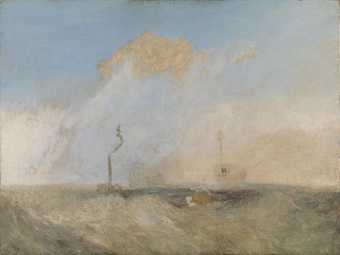
Joseph Mallord William Turner
Steamer and Lightship; a study for ‘The Fighting Temeraire’ (c.1838–9)
Tate
But Turner’s radiant and radiating planes of light, and the darkness of his storms, also recall Faraday’s work on electromagnetism, the lines of force encompassing the globe. Snow Storm – Steam-Boat off a Harbour’s Mouth c.1842 builds on a long, close observation of the sea, but critics have also pointed out how the vortex of waves and sky recalls the swirling patterns that Faraday’s iron filings made when he moved a magnet beneath them. Turner’s evanescent rainbows also gain from contemporary research, such as the work on optics and the spectrum by the physicist David Brewster, whose Edinburgh circle Turner knew well. Even his whaling paintings benefited from expert friends, including the zoologist Richard Owen, who urged the Royal Society to encourage whalers to collect specimens and keep records of the phenomena and natural creatures they saw in the Arctic and the South Seas.
The increased understanding of natural forces and combustion, and refined skills in engineering, powered the age of steam – the signature of the new, driving mills and printing presses, factories and laundries, ships and then trains. Turner’s sketchbooks are dotted with steamboats and they figure often in his paintings, such as Staffa, Fingal’s Cave 1831–2. Here the boat steams on while, Turner remembered, ‘the sun getting towards the horizon, burst through the raincloud, angry’.
In The ‘Fighting Téméraire’ Tugged to Her Last Berth to Be Broken Up 1838, painted the year after Victoria took the throne, the ghostly ship that had served at Trafalgar glides upriver, pulled by a puffing, clanking, little steam tug. It is a moment of handover, of balance. The moon is rising, while the sunset – a signal of ending – is misplaced in the east downriver, hinting, perhaps, at the dawn of a new age.
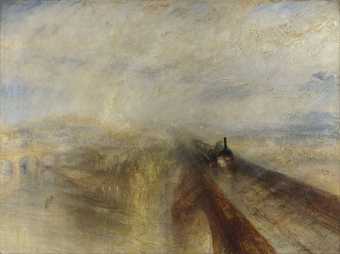
J.M.W.Turner
Rain, Steam and Speed – the Great Western Railway 1844
Oil paint on canvas
© The National Gallery, London
‘Steam,’ wrote Mary Somerville, ‘annihilates time and space.’ Nostalgia has no place in Turner’s Rain, Steam and Speed – the Great Western Railway, exhibited in 1844, a tribute to the elemental power of steam, and also to the engineer Isambard Kingdom Brunel. Critics had doubted that Brunel could overcome the difficulties of this spot, where the train emerges from a tunnel and crosses high above the Thames at Maidenhead. They believed the bridge would be bound to collapse. But the bridge held, defying all. And, as the train emerges from the mist, its firebox a violent, crackling daub of white and red, Turner shows us natural power harnessed, and the future, exhilarating and powerful, rushing towards us across the bridge of time. It was a painting unlike any seen before.
Turner never shirked the dark side of his times: the lust to rule, the poverty and oppression. But he responded intensely to its possibilities – to the ambition of inventors, the daring of engineers, the discoveries of scientists, and to the way his age seemed to be hurtling into a new technological future. His paintings of light and air, of sea and land, are full of wonder and he adapted his techniques – slashing and scraping, blotching and blurring – to suggest that the social realm, too, was always on the cusp of change, dynamic and evolving. In this, more than anything, he was a painter of the modern world.
Turner’s Modern World, Tate Britain, 28 October – 7 March 2021. Co-curated by David Blayney Brown, Senior Curator, British Art 1790– 1850, Amy Concannon, Curator, British Art 1790–1850, James Finch, Assistant Curator, 19th Century British Art and Sam Smiles, Honorary Professor, Art History and Visual Culture, University of Exeter with Hattie Spires, Curator, British Art. Supported by the Manton Foundation. With additional support from the Turner’s Modern World Exhibition Supporters Circle, Tate Americas Foundation, Tate Patrons and Tate Members. Organised by Tate Britain in association with the Kimbell Art Museum and the Museum of Fine Arts, Boston.
Jenny Uglow is a biographer, historian and critic, and former Editorial Director of Chatto & Windus

